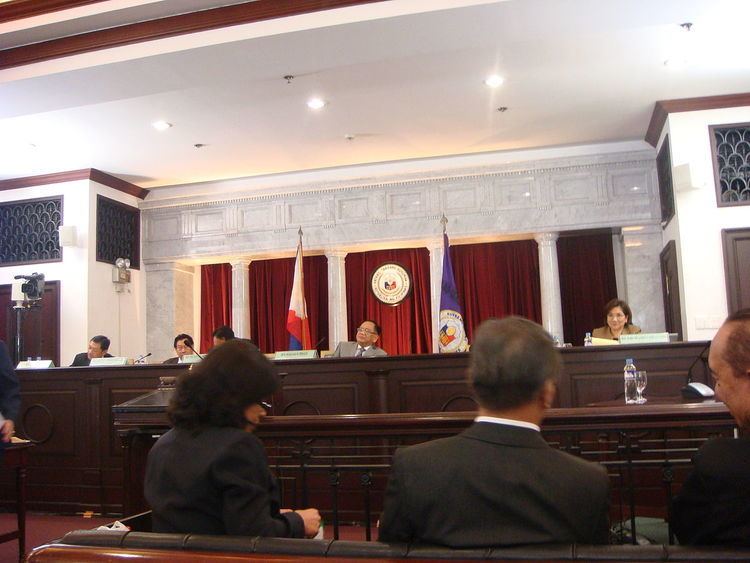 | ||
The Judicial and Bar Council (JBC; Filipino: Sangguniang Panghukuman at Pang-abogasya) of the Philippines is a constitutionally-created body that recommends appointees for vacancies that may arise in the composition of the Supreme Court, other lower courts, and the Legal Education Board, and in the offices of the Ombudsman, Deputy Ombudsman and the Special Prosecutor.
Contents
Composition
The Council is composed of a representative of the Integrated Bar, a professor of law, a retired member of the Supreme Court, and a representative of the private sector. They are the "regular" members, as opposed to the Secretary of Justice and a representative of Congress who are the ex officio members. The Chief Justice of the Supreme Court is the ex officio chairman, while the Clerk of the Supreme Court shall serve as the ex officio secretary.
The regular members would be nominated by the President with the consent of the Commission on Appointments for a term of four years. However, since the terms will be staggered, the first set of members would a different lengths of service: the representative of the Integrated Bar shall serve for four years, the professor of law for three years, the retired Justice for two years, and the representative of the private sector for one year. The following members shall be given the full four-year term.
The regular members were allowed to be reappointed without limit. The Secretary of Justice serves at the pleasure of the president, while the representative of Congress serves until they are recalled by their chamber, or until the term of Congress that named them expires. Finally, the Chief Justice serves until mandatory retirement at the age of 70. The regular members' terms start at July 9.
In 2012, a petition at the Supreme Court questioned on who should occupy the seat allocated for Congress. Currently, there are two members of Congress in the council: the chairman of the House of Representatives Committee on Justice and the Chairman of the Senate Committee on Justice and Human Rights. The Supreme Court ruled in 2013 that there should only be one member of the JBC from Congress; the court left to Congress whom among the two would be its representative to the JBC.
The council is the only government body that has members from all three branches of the government, excluding ad hoc and advisory bodies.
Current membership
The members of the Judicial and Bar Council are:
Ex officio chairman
Ex officio members
Regular members
As a matter of tradition, the two (2) senior associate justices of the Supreme Court also take part in the JBC deliberations.
Function
The function of the Council is to recommend to the representatives
of possible appointees to the Judiciary.The president shall choose from among those nominated, before the president may ask the Council to nominate somebody else and add it to the list, but this is not allowed anymore. The person then chosen by the president then becomes a member of the Judiciary, and is not anymore reviewed by the Commission on Appointments. This is to prevent politicking and horse-trading among political parties.
Prior to the creation of the JBC, judges and justices were appointed by the president as per and the 1973 constitution, and with confirmation by the Commission on Appointments as per the 1935 constitution.
Former Chief Justice Artemio Panganiban said that the Council's principal objective is to attract the best and brightest to the judiciary and to make them remain there.
Members
The members of the JBC were:
Representative from Congress
Since the creation of the JBC in 1987 until 1994, the representation for Congress in the body alternated between the House of Representatives and the Senate, by their respective Chairman of the Committee on Justice.
Two representatives, half a vote each
By 1994, the two representatives from Congress began sitting simultaneously, each having one-half of a vote.
Two representatives, one vote each
On May 30, 2001, the JBC En Banc decided to grant the representatives from both Houses of Congress one full vote each.
One representative
On 2013, the eight-member composition of the JBC was questioned at the Supreme Court. The Supreme Court restored the composition of the JBC to seven. It was arranged that the representative of the House of Representatives sits from January to June, while the representative of the Senate sits from July to December.
